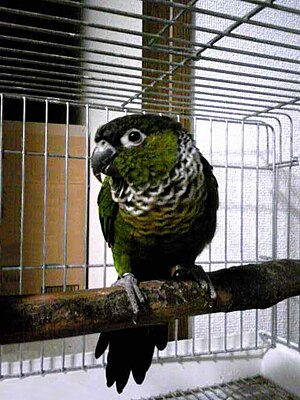Black-capped Parakeet
| Black-capped Parakeet | ||||||||||||
|---|---|---|---|---|---|---|---|---|---|---|---|---|

Black-capped Parakeet in captivity . |
||||||||||||
| Systematics | ||||||||||||
|
||||||||||||
| Scientific name | ||||||||||||
| Pyrrhura rupicola | ||||||||||||
| ( Tschudi , 1844) |
The black cap parakeet ( Pyrrhura rupicola ) is a species from the genus of pyrrhura ( Pyrrhura ) in the family of the actual parrots (Psittacidae).
features
The black-capped parakeet reaches a body length of 25 cm and a weight of 75 g. It is a predominantly green, long-tailed New World parrot. From the forehead to the nape of the neck it is dark brown, on the throat, sides of the neck and upper chest with whitish feather edges. The featherless orbital ring is white, the face and ear covers are green. The wings of the hand and arm are essentially bluish green, with thin black tips on the top and dark green on the underside with green under wing-coverts. The outer coverts , the alula and the front edge of the wings are bright red. The belly and lower tail-coverts are green, with a maroon tone in the central part of the belly.
The beak is slate gray, the wax skin pale gray and the legs blackish. The iris is brown.
In the subspecies Pyrrhura rupicola sandiae , the whitish fringes of the feathers on the chest, throat and sides of the neck are narrower than in the nominate form , the light feather fringes are not present on the neck.
distribution
The nominate form occurs in central Peru , the subspecies Pyrrhura rupicola sandiae in southeastern Peru and in the extreme west of Brazil and northern Bolivia .
Habitat and way of life
Black- capped Parakeets inhabit moist lowland tropical forests as well as Várzea and Terra Firme landscapes, the species is less common in the eastern foothills of the Andes . In general, black-capped parakeets live up to a height of 300 m. They are sociable animals that come together in groups of up to 30 individuals; in the breeding season they prefer smaller groups. They are usually found in the treetops, where they also look for food and fly around. The Black-capped Parakeet rarely goes below 30 m in height. Little is known, however, about their diet and reproduction.
Subspecies
Two subspecies are described:
- Pyrrhura rupicola rupicola ( Tschudi , 1844)
- Pyrrhura rupicola sandiae Bond & Meyer de Schauensee , 1944
Hazard and protection
Based on a model of future deforestation in the Amazon basin and the associated loss of habitat , it is assumed that the population of this species will decline by 25 to 30% over the next three generations (18 years). In addition, the black- capped parakeet is threatened by hunting and catching. It is therefore classified as Near Threatened (NT) by the IUCN (International Union for Conservation of Nature and Natural Resources).
No protective measures are known.
Individual evidence
- ↑ a b c N. Collar, A. Bonan, P. Boesman: Black-capped Parakeet (Pyrrhura rupicola). In: del Hoyo, J., Elliott, A., Sargatal, J., Christie, DA & de Juana, E. (eds.). Handbook of the Birds of the World Alive. 2016, Lynx Edicions, Barcelona. ( Online )
- ↑ a b c d e Mike Parr, Tony Juniper: Parrots: A Guide to Parrots of the World. Bloomsbury Specialist, 2003, ISBN 978-0713669336 , pp. 468-469.
- ↑ Videos, photos and sound recordings on Black-capped Parakeet (Pyrrhura rupicola) in the Internet Bird Collection
- ^ IOC World Bird List New Zealand parrots, cockatoos & parrots
- ↑ a b IUCN
Web links
- Pyrrhura rupicola inthe IUCN 2015-4 Red List of Threatened Species . Listed by: BirdLife International, 2012. Retrieved March 19, 2016.
- Black- capped Parakeet ( Pyrrhura rupicola ) at Avibase